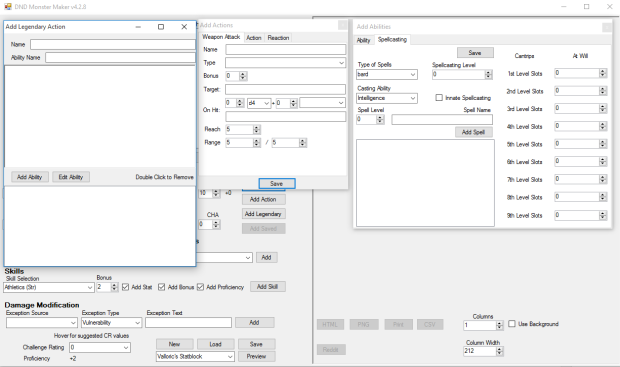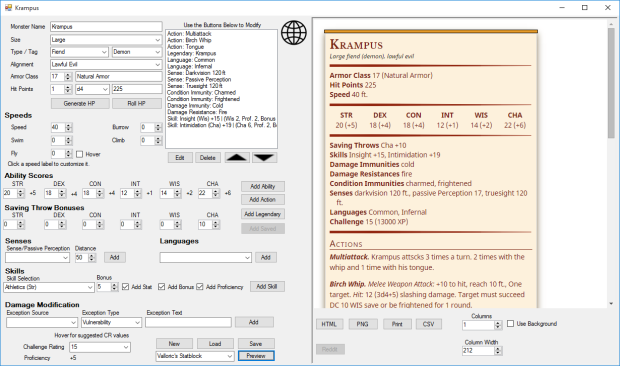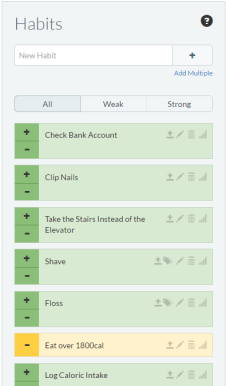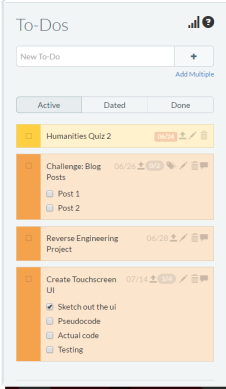
Sorry this is a month late! I got really busy wrapping up college, but that’s officially over! I’m out of the country until September starting Thursday so there may be time for 1 more post before that happens.
My two favorite classes in 5e are Bard and Battle Master Fighter. They both offer interesting combat choices, potential utility, and a lot of great role-playing opportunities. This character build combines the best of both worlds through multiclassing to make a front line damage dealer that can provide themselves and their party members with extra support.
Please don’t hesitate to give me some feedback on the layout and the content of this. I want to have these monthly builds to eventually have a uniform layout!
Base Character
The Song Master Fighter will thrive by being both nimble and witty. Utilizing finesse melee weapons or ranged weapons will be key in order to not stress the wide stat distribution needed for this multiclass. With good enough stat rolls, however, you could make the Song Master Fighter be more Strength focused. The play style is not much different. The build itself is based around giving the player many different options during combat and outside of it, it’s a very jack-of-all trades build with a focus on combat.
Class
Fighter (17)/Bard(3)
Level 1: Fighter (1)
Level 2-4: Bard (3)
Level 5-20: Fighter (17)
The idea here is to go Fighter 1st level. This gives you proficiency with all weapons and armor and some really nice choices for weapons, armor, and adventuring supplies. You’ll also get access to a Fighting Style and Second Wind. Sure you’ll miss out on Spellcasting for this first level, but this is a solid amount of stuff, much of which you’d miss out on by taking Fighter at a later point. By this I mean that when you multiclass into Fighter you do not get proficiency with the skills (Bard gets a lot of these still), but more importantly you miss out on Heavy Armor proficiency which can be pretty huge if you want to be a front line character.
The saves for starting out as a Fighter as opposed to a Bard are a nice plus for this character as well. Bard gives us DEX and CHA saves which are coincidentally our two best stats. These are excellent saves, don’t get me wrong, but having CON and STR as our proficient saves will be pretty valuable for dealing with threats in melee combat. Also if we happen to pick some spells that require concentration, that proficiency in CON will come in handy.
Note: Realistically you can swap this around to any combination, however I feel like this is the “sweet-spot” for having a real front-line Song Master Fighter. You’ll get your level 2 Bard spells and Bard Archetype plus your second usage of Action Surge and third usage of Indomitable.
Race
In order from best to worst:
- Halfling
- Variant Human
- Elf, particularly Dark Elf (Drow)
- Half-Elf
- Dragonborn
Halfling is top tier for this build in my opinion. It grants a flat-out +2 DEX and the two subraces give either +1 CHA or +1 CON which are both very beneficial to this build. The Lucky ability from being a Halfling is very, very good for any class with multiple attacks each turn which is something this build will be gearing up towards in the middle-to-later levels.
Variant Human is always a great choice. Being able to grab a feat 4 levels early can be an enormous advantage, plus the extra skill proficiency and 2 +1 ability score increases are great bonuses for this build.
Elves get a +2 bonus to Dexterity, and since that is the way I’m building the Song Master Fighter from the get go I’m going to value any DEX increases I can get. The Wood Elf and High Elf subraces are both decent and they will grant you some extra weapon proficients if you choose to start as a Bard instead of a Fighter. Drow in particular is a bit tricky to play in a large amount of settings, but if you can pull it off I would highly using this race for a Song Master Fighter. It is by far the best subrace for this build, but if you are in a campaign where you will be in the sunlight a significant amount of time I would suggest picking a different race/subrace.
Half-Elf, like Variant Human, is always a solid choice for a character. They have a +2 CHA ability score increase along with 2 skills and 2 +1 ability score increases. They also have advantage on saving throws against being charmed and an immunity from being put to sleep. Darkvision is also a great bonus.
Lastly, we have Dragonborn which are in general pretty solid characters all around. They boast a +2 STR and +1 CHA increase which could potentially let you swap from the DEX based Fighter in this build to a STR based one. The breath weapon and damage resistance is always welcomed by any character.
Note: Race doesn’t have a huge impact in 5e. It’s certainly advantageous to pair your build with a race that grants it good abilities/stat bonuses, but it’s not needed. I also only included races from the PHB in this guide.

Background
Background is more of a dealer’s choice sort of scenario, but my personal favorites for this would be Entertainer (PHB 130), Soldier (PHB 140) or Sailor (139). They all provide some sort of physical skill (Athletics/Acrobatics) and a social skill (Performance/Intimidation). The Sailor’s Perception proficiency is useful for pretty much any class so that’s fine to take instead of the Performance/Intimidation from the other two backgrounds.
Realistically though, choose a background that you enjoy the most. Taking the levels in Bard will grant you half proficiency in all skill checks regardless so you’ll get a bit more leeway for “missing out” on an ideal background for a more fun one.
Stat Distribution
I’m going to use the Standard Set (15, 14, 13, 12, 10, 8) here for my stat distribution. You can swap the DEX and STR scores if you’d rather a more STR based Song Master Fighter instead of a DEX based one.
STR 12
DEX 15
CON 13
INT 8
WIS 10
CHA 14
Note: In this case, INT and WIS are really only useful for spell saves or skills. I chose to use INT as my dump stat as in general most saves in the game revolve around DEX/CON/WIS. Very few things will kill you because of a low INT roll, though if you run into an Intellect Devourer at some point you may be very, very dead.
Stat Priorities/Ability Score Improvements
The real weakness of this build is that you’ll be getting your ability score improvements (ASI) much later than a character that does not multi-class. This means that every single ASI we get will be cherished. Not to mention the fact that we’ll potentially want to use the few ASIs we get for a feat or two. Regardless, if we go through the build we’ll get 6 total ASIs, assuming we make it to level 20. You can do a ton with 6 ASIs, but the fact of the matter is we won’t be getting our first one until character level 7 whereas most players will get them at level 4.
Regardless, take a look at your stats. Personally I’ll want to beef my DEX up to max, my CON up a little bit, and my CHA up a tad to make spell saves harder for the enemy. Here’s a quick example of what I might choose to increase given the stats I allocated in the last section.
ASI 1 (level 7/Fighter 4): +1 DEX + 1 CON (DEX 16, CON 14)
ASI 2 (level 9/Fighter 6): +2 CHA (CHA 16)
ASI 3 (level 11/Fighter 8): +2 DEX (DEX 18)
ASI 4 (level 15/Fighter 12) +2 CON (CON 16)
ASI 5 (level 17/Fighter 14) +2 DEX (DEX 20)
ASI 6 (level 19/Fighter 16) +2 CON or +2 CHA
If I’m not a Variant Human I’d probably take a feat at either the 1st or 2nd ASI depending on how poorly I rolled on my abilities. If I had something like the standard set I would most likely take the stats at ASI 1 and the feat at ASI 2. You can swap around the increase to CON and CHA at any point if you feel your character needs some more survivability as opposed to spellcasting prowess.
I’d potentially take another feat somewhere in there, especially if I rolled some great stats. Feats are always more fun than just a basic stat increase and sometimes even come with a +1 to a stat.

Feats
As I mentioned in the last section I’ll want to take a feat or two at some point in this build since I personally find feats to be a lot more fun than a standard ASI. There are also some feats that work VERY well with this character build so I’ll be mentioning those instead of every single feat available. All the spells are listed on pages 165-170 of the PHB.
Alert – This one is great as it gives you bonuses to initiative to allow yourself to better setup the encounter for yourself and your party by using spells such as Faerie Fire or Thunderwave while going ahead of the rest of the party. With less party members in the area of your AoE spells, the better. Not being able to be surprised while conscious and creatures unable to gain advantage on attack rolls from being hidden from you are icing on the cake. It’s not particularly exciting, but it’s very good.
Defensive Duelist – If you are thinking of taking the duelist Fighting Style or are thinking of wielding finesse weapons in general this will be a great feat to accompany that. This allows you to use your reaction to add your proficiency to your AC for an attack. This can allow you to completely escape a melee attack, and completely avoiding damage is always a huge bonus.
Dual Wielder – If you’re thinking of taking the Two-Weapon Fighting, Fighting Style this is a great choice for a feat since you’ll now get +1 AC while dual wielding and have the ability to use a non-light melee weapon in one of your hands. It’s a pretty solid feat in my opinion as it will allow you to be even better at melee combat.
Magic Initiate – I honestly hadn’t thought a lot about this one until @Kordwar had mentioned it to me on Twitter. A great option to use this with since you’d be in melee range so often is to choose the Cleric class and get Inflict Wounds as your 1st-level spell. This allows you to deal a whopping 3d10 necrotic damage without much of an issue once per long rest. He also recommended Thaumaturgy and Spare the Dying for the cantrips.
Lucky – Honestly this feat is very powerful for almost any build. In this case you essentially get 3 more uses of Cutting Words if you so choose. Of course Cutting Words will always be beneficial, this one is a bit more of a shot in the dark, but the intention is similar. It’s very good and provides a lot of utility.
War Caster – I would highly recommend taking this feat with practically any Fighting Style chosen in this build. This allows you to use spells for opportunity attacks, but most importantly, you gain advantage on Constitution saves to maintain concentration. You’re going to be in the middle of melee combat so prepare for MANY concentration saves. Having advantage on these will be huge. In addition being able to perform somatic components while you are wielding weapons or a shield in your hands is another large bonus for this build. This feat feels as if it were made for a Song Master Fighter.
Class Feature Choices
This section is going to depend entirely on how you want to build your Song Master Fighter, but for the default of 3 Bard/17 Fighter this is what I’ve thought up.
Bard
Advancing 3 levels into Bard will nab you Spellcasting, Bardic Inspiration (d6), Jack of all Trades, Song of Rest (d6), Expertise, and the choice of your archetype. This is a lot of utility for so very few levels, but not a lot of actual choices to make.
Expertise
“At 3rd level choose two of your skill proficiencies. Your proficiency bonus is doubled for any ability check you make that uses either of the chosen proficiencies.”-PHB page 54
So not including races or backgrounds the skills that we could potentially choose from will be the Fighter skill list since we’re taking our 1st level in Fighter. This means that we can choose between Acrobatics, Animal Handling, Athletics, History, Insight, Intimidation, Perception, and Survival. Again this will depend on what you want to do with your character, but in my opinion our top choices here are Acrobatics, Athletics, Intimidation, and Perception.
Acrobatics will allow us to traverse some dex-based difficult terrain, but most importantly giving us a tool to escape a grapple if we do not have a high strength or Athletics skill.
Athletics has the benefit of doing things such as climbing a mountain, swimming, and other types of athletic movement. Expertise in this skill will give us a better chance at grappling a target as well as escaping a grapple. If you intend to be grappling at any point I would highly recommend this skill for one of your 2 expertise choices.
Intimidation can be a good choice for this as we’re already going to have a high CHAR score due to being a Bard, plus it gives us another tool to interact with NPCs or enemies. This is a good choice for someone who is looking to be “the face” or more of a role player than just focusing on combat.
Perception is always a great skill to have since so many skill checks will rely on this. It’s a very safe choice if you can’t decide on a better one of your skills to pick from.

Spellcasting
The largest choices you’ll have to make will be from deciding what spells to pick throughout your 3 levels. You will be able to learn a total of 2 cantrips, 5 1st level spells, and 1 2nd level spell which leaves us at many choices. Remember that you’re going to mainly be a Fighter so realistically we should be picking spells that help us deal more weapon damage, help our party members out, or make it harder for our enemies to hurt us.
Cantrips
Blade Ward – So this is probably a more controversial choice as you have to essentially forego your action to get 1 turn of resistance against bludgeoning, piercing, and slashing damage dealt by weapon attacks. I think that as far as cantrips go its decent, but it’s a pretty situational use since you would have to be expecting to be dealt enough weapon damage to forego say extra attacks, a better spell, or any other action.
Light – If you are in an area with low light and you are playing a race without darkvision this can be an extremely handy cantrip to pickup. This would allow you to see in low light/no light without having to use a hand to hold a light source.
Minor Illusion – This could be a fun one to essentially make a copy of yourself or something hostile and potentially trick an (extremely gullible) enemy into wasting an attack or action on the 5ft cube illusion you’ve made, or potentially distract enemies with a sound coming from a different location. This one can be a fun choice more than anything.
Vicious Mockery – I really like this spell as a choice for the Song Master Fighter, especially if you are not going to have a lot of ranged options in your build. This will allow you to attack from 60ft away if you won’t be able to get into melee range within a single movement. In addition to this you’d also impose disadvantage on the enemy which can result in avoiding some damage once you get in range of them. It’s very powerful if the enemy cannot make the Wisdom save.
1st Level Spells
Charm Person – Even though we focus on combat with this build, sometimes it’s better to completely avoid a fight. This is a spell that can absolutely help you and your companions do just that. This is a very powerful spell if used intelligently and I find myself enjoying spells like Charm Person more than anything because it is a tool to help you roleplay.
Cure Wounds – With us having action surge in this build I’m less hesitant to take spells that use actions. Cure Wounds is a good spell if you’re low on healing in your party, and the ability to action surge to still deal damage on your turn mean you won’t lose a whole round of damage by healing someone.
Faerie Fire – This spell allows us to make a 20-foot cube and impose a DEX save on those inside of it. This lights up and outlines those that failed and gives anyone attacking those outlined creatures advantage and those creatures cannot become invisible. Very powerful if used right and you can maintain concentration on the spell.
Healing Word – This is a great utility spell as it allows you to heal yourself or an ally for 1d4 + spell mod while only using your bonus action. Unless you are dual wielding with this build there are not a lot of other things you’ll be using a bonus action for so this at least gives us an option to use it.
Sleep – This spell gets less useful at the higher levels when the enemies have more HP, but for the lower levels this is a great way to incapacitate a few enemies and give yourselves advantage on attacks and crits on attacks made within 5ft of an affected creature.
Thunderwave – Since this build is more melee focused it’s easier for you to get in the middle of a lot of enemies and just throw them all away at will. This sort of displacement can be very useful to give the party more time to react to enemies and it can give your ranged combat party members a bit more distance to work with.
2nd Level Spells
Hold Person – In my opinion this spell is the best choice for this build as it allows you to completely incapacitate an enemy this also allows you to gain advantage on attacks against the affected creature as well as all attacks made within 5ft of the target being crits. Very awesome spell and I frankly don’t think any other of the 2nd level spells come close to this much synergy with our kit.
Fighter
As we will be placing the vast majority of our levels in Fighter we will be gaining every fighter class feature with the exception of one ASI, increasing our superiority dice to d12s, and Extra Attack (3). These are all good perks of going fullblooded fighter, but that would defeat the purpose of this guide. Regardless at base we’ll need to decide a few things. Obviously the ASIs but we already did that, our archetype, but most importantly our Fighting Style.
Any of these are perfectly viable with this character so it’s really up to you if what type of Song Master Fighter you want to go with. My top choices would be Dueling, Defense, or Two-Weapon Fighting, but let’s take a look at everything.
Archery – +2 bonus to attack rolls with ranged weapons which is always nice. Personally I envision the Song Master fighter to be more melee focused with the maneuvers and whatnot, but this is a solid style to choose.
Defense – This one is always great as you gain a bonus +1 AC while wearing any sort of armor. Very powerful as this will give you a bit more survivability.
Dueling- I normally overlook this one to be honest, but it’s got excellent synergy for someone who may not want to take War Caster for a feat. You’ll always have 1 hand free to meet the requirements for the somatic component of spells, plus you get a flat +2 to all damage rolls with your weapon. This is a good pick for this build in my opinion.
Great Weapon Fighting – This is a solid choice as well if you are intending to be more STR based Fighter as you can now reroll your 1s and 2s for a better chance at hitting. By the rules you still would not necessarily have to unequip your weapon or have War Caster in order to meet the somatic component requirements as you can still hold your weapon with 1 hand while you quickly do the gestures.
Protection – This one has always felt weird to me as there are just so many requirements for this to work out in your favor whereas all of the other choices we have are effective all of the time. Pass on this one in my opinion.
Two-Weapon Fighting – If you’re planning on grabbing the War Caster feat this is a fun Fighting Style to grab since you would not need a free hand for your somatic spells. This allows you to still use a bonus action to attack with an offhand weapon as usual, however you can now add your ability modifier to your offhand weapon damage.

Class Archetype Choices
Bard – College of Lore
College of Lore is the best choice for this build in my opinion. College of Valor is absolutely viable, but I really prefer Cutting Words as opposed to Combat Inspiration. As we will only be putting 3 levels into Bard this is really the only choice that we’ll have to make. The other choice is just what 3 skills do we want to put proficiency in, but that’s more of a personal preference at this point than anything.
Cutting Words – With this ability you can use one of your uses of Bardic Inspiration to subtract the number rolled on your Bardic Inspiration from their attack, ability check, or damage role. This will use a reaction, but still we can essentially subtract a d6 (3.5 avg) from an enemy’s weapon attack which could allow us or one of our allies to completely avoid damage.
Combat Inspiration – This ability allows you give a creature a Bardic Inspiration die and add that to say their weapon damage roll they made, or they can use their reaction to add their Bardic Inspiration to their AC to attempt to avoid being hit.
Combat Inspiration is still a very good feature, but I feel as though you as the player get less control over what happens as the decision is left up to your peers. Another point I would like to make is that Combat Inspiration cannot affect an enemy creature’s ability check whereas Cutting Words can. Using Cutting Words to make a creature say fall off a trapeze and plummet to their death could be a great perk.
Fighter – Battle Master
This is really a non-negotiable choice for this build. You have to pick Battle Master as this is the real bread and butter of this build. However, some choices you can make are what artisan’s tools you are proficient with as well as what maneuvers you wish to choose. Let’s look at the pros and cons of each! At our 3rd Fighter level we can pick 3, but we gain an additional 2 at 7th, 10th, and 15th Fighter level.
Commander’s Strike – This one can be kinda fun and especially great if you have a Rogue (extra sneak attack damage) but otherwise it’s pretty hard to choose this one to use both a bonus action and forego one of your attacks. Very situational, but if you have a good Rogue this could be a great tag-team ability.
Disarming Attack – Removing a weapon from an opponent is always a good choice plus you’ll get some bonus damage even if your opponent makes the save. Definitely good.
Evasive Footwork – Being able to give yourself some bonus AC to move around can allow you to make a dash action through enemies rather than using your action to go about half the movement and disengage. Situational, but decent.
Feinting Attack – This gives us another option to use for our bonus actions on our turns. You now can give yourself both advantage on your next attack to that creature and bonus damage to that creature assuming that attack hits. Very good.
Goading Attack – One of the few “taunts” in 5e. If a creature fails the save on this one they have disadvantage on all attacks on targets other than you until the end of your next turn. This one is an excellent choice if you have decent AC and HP as this fits the theme of utility + front line we’re going for in this build.
Lunging Attack – Being able to attack an additional 5 feet away can be good, but it’s pretty situational in this build, especially where we have other ranged options. Very situational.
Maneuvering Attack – This can be a decent utility maneuver for getting allies out of melee range of a large threat. Though I’m not sure it’s a great option compared to some of the other maneuvers we have to pick from. Very situational at best.
Menacing Attack – This is a great attack to buy yourself from time from an enemy if you are at low hp. This will potentially get this creature to not only attack other targets, but have disadvantage on all Ability Checks and Attack rolls while you’re within their line of sight. Very good and it fits our theme well.
Parry – Great choice if you find yourself getting hit a lot. It’s a very solid choice in general so I can’t imagine it being a bad option for this build.
Pushing Attack – This one is decent and like Thunderwave it can give your back-line a bit more distance to work with. Unfortunately, this will only work on a single creature. Situational but decent.
Rally – I feel like giving your allies some temporary HP is pretty decent, plus it uses our Charisma modifier which is one of our better stats in this build. Decent and it fits the theme we’re going for.
Riposte – This can be a fun one as you’ll be able to get an extra swing on an enemy with some bonus damage. Good choice and pretty reliable.
Sweeping Attack – A cleave ability is always a great pick for a fighter especially if you find yourself fighting lots of groups of weaker enemies. It’s also free damage in many cases so it’s certainly not a bad choice. Good choice.
Trip Attack – I like this one as it’s another utility based ability wrapped in some nice damage. Knocking a creature prone gives way to allies getting advantage on attacks against that creature. It’s a good choice and fits with our theme well.
Conclusion
As I said before during this build I really enjoy what both the Battle Master Fighter and the Bard have to offer for a player in 5e. This was an attempt at giving you some of the best of both worlds. You’re able to provide the party with some great utility but still deal some solid damage as a front-line fighter. There are a few weaknesses to this build as you won’t be nearly as tanky as a full on front-line Fighter and not as great of a caster as a pure Bard, but you have a lot of options.
On any given turn you’ll be able to make many choices for what you want to do and you even have some great options to work with on reactions. This also has some awesome elements for role-playing as you’ll have expertise in some skills, many skills to choose from, and jack of all trades for any skills that you didn’t put proficiency in!
This was definitely a bigger build than the last one I threw together, so feel free to chime in on this! I had a lot of fun and honestly learned a ton about both classes while I was going through everything.
-Eld









.png/184px-Angry_Chicken(57).png?version=9c1fd0b016514d29ecc1985d2366daa1)













